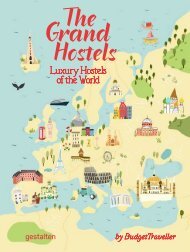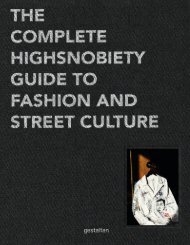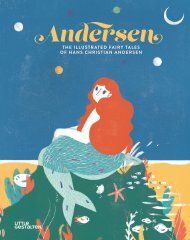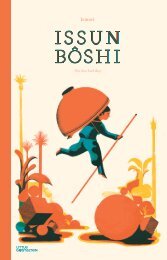The Big Book of Treasures – Leseprobe
Embark on an adventure with world-famous treasure hunters and learn more about gold lost at the bottom of the sea, even a stolen football trophy.
Embark on an adventure with world-famous treasure hunters and learn more about gold lost at the bottom of the sea, even a stolen football trophy.
Create successful ePaper yourself
Turn your PDF publications into a flip-book with our unique Google optimized e-Paper software.
T he<br />
<strong>Big</strong> <strong>Book</strong> <strong>of</strong><br />
<strong>Treasures</strong><br />
THE MOST AMAZING<br />
DISCOVERIES EVER MADE<br />
AND STILL TO BE MADE<br />
Raphael Honigstein<br />
Caroline Attia
Written by Raphael Honigstein<br />
Illustrated by Caroline Attia<br />
This book was edited and designed<br />
by Gestalten.<br />
Written by Raphael Honigstein<br />
Illustrated by Caroline Attia<br />
Editorial Management by<br />
Maria-Elisabeth Niebius<br />
Design and layout by Hendrik Hellige<br />
and Léon Giogoli<br />
Copy-editing by Ben Barlow<br />
Published by Little Gestalten,<br />
Berlin 2017<br />
ISBN: 978-3-89955-797-8<br />
<strong>The</strong> German edition is available under<br />
ISBN 978-3-89955-796-1.<br />
Typefaces: Thirsty Rough<br />
by Ryan Martinson, Tintin<br />
Printed by Nino Druck GmbH,<br />
Neustadt/Weinstraße<br />
Made in Germany<br />
All rights reserved. No part <strong>of</strong> this<br />
publication may be reproduced or<br />
transmitted in any form or by any<br />
means, electronic or mechanical,<br />
including photocopy or any storage and<br />
retrieval system, without permission in<br />
writing from the publisher.<br />
Respect copyrights, encourage creativity!<br />
For more information, please visit<br />
little.gestalten.com.<br />
Bibliographic information published by the<br />
Deutsche Nationalbibliothek:<br />
<strong>The</strong> Deutsche Nationalbibliothek lists this<br />
publication in the Deutsche<br />
Nationalbibliografie; detailed bibliographic<br />
data are available online at<br />
http://dnb.d-nb.de.<br />
This book was printed on paper certified<br />
according to the standards <strong>of</strong> the FSC®.<br />
T he<br />
<strong>Big</strong> <strong>Book</strong> <strong>of</strong><br />
<strong>Treasures</strong><br />
THE MOST AMAZING<br />
DISCOVERIES EVER MADE<br />
AND STILL TO BE MADE<br />
2 3
<strong>The</strong> Whydah Gally<br />
4<br />
King John’s Treasure<br />
40<br />
<strong>The</strong> Sass Brothers<br />
32<br />
<strong>The</strong> Archaeopteryx<br />
52<br />
36<br />
<strong>The</strong> Fabergé Eggs<br />
<strong>The</strong> Amber Room<br />
48<br />
<strong>The</strong> Tomb <strong>of</strong> Genghis Khan<br />
68<br />
<strong>The</strong> SS Gairsoppa<br />
28<br />
<strong>The</strong> Priam’s Treasure<br />
64<br />
76<br />
88<br />
<strong>The</strong> Nuestra Señora de Atocha<br />
80<br />
<strong>The</strong> Bactrian Gold<br />
8<br />
44<br />
92<br />
<strong>The</strong> Terracotta Army<br />
60<br />
La Noche Triste<br />
«<strong>The</strong> Night <strong>of</strong> Sorrows“<br />
16<br />
<strong>The</strong> Lascaux Cave<br />
12<br />
<strong>The</strong> Rosetta Stone<br />
<strong>The</strong> Menorah<br />
24<br />
56<br />
72<br />
<strong>The</strong> Concepción<br />
20<br />
El Dorado<br />
<strong>The</strong> Treasure <strong>of</strong> the Nibelungen<br />
<strong>The</strong> Ark <strong>of</strong> the Covenant<br />
<strong>The</strong> Tomb <strong>of</strong> Tutankhamun<br />
<strong>The</strong> Jules Rimet Trophy<br />
4 5<br />
84<br />
<strong>The</strong> Padmanabhaswamy Temple
<strong>The</strong><br />
Whydah Gally<br />
300 YEARS AGO, THE CARIBBEAN TEEMED WITH PIRATE SHIPS.<br />
BUT ONLY ONE — THE WHYDAH GALLY OF THE FAMOUS<br />
CAPTAIN “BLACK SAM” — WAS FOUND AS A SHIPWRECK, ALONG<br />
WITH STOLEN TREASURES AND THE REMAINS OF<br />
THE YOUNGEST EVER PIRATE: AN 11 YEAR OLD BOY.<br />
Eleven-year-old John King and his<br />
mother were passengers on a boat<br />
called Bonetta, traveling from Antigua<br />
to Jamaica on November 9, 1716, when<br />
a frightened cry went out: “Pirates!”<br />
Within no time, the famous Samuel<br />
“Black Sam” Bellamy and his crew <strong>of</strong><br />
scoundrels captured the ship. After 15<br />
days <strong>of</strong> looting, Black Sam, who owed<br />
his nickname to his long black hair,<br />
was ready to move on, but a little<br />
voice shouted at him to wait. “I want<br />
to join you!” demanded John. Black<br />
Sam laughed at the boy’s wish. But<br />
John would not take no for an<br />
answer. He threatened to hurt his own<br />
mother if he was not allowed to go.<br />
<strong>The</strong> pirates were impressed by such<br />
terrible behavior and agreed to take<br />
John on as a crew member.<br />
Bellamy, who had served in Britain’s<br />
Royal Navy before turning into an<br />
outlaw on the seas, was incredibly<br />
good at pirating. He seized 53 boats<br />
in only one year, becoming incredibly<br />
rich in the process. “<strong>The</strong> Prince <strong>of</strong><br />
Pirates,” they called him, for he was a<br />
rather polite pirate, tidily dressed in<br />
velvet coats and well mannered.<br />
In February 1717, Black Sam pulled<br />
<strong>of</strong>f his biggest coup, capturing the<br />
Whydah Gally near the Bahamas. <strong>The</strong><br />
112-foot-long (34-meter-long) British<br />
ship had sailed from Benin in West<br />
BELLAMY, WHO HAILED FROM DEVONSHIRE<br />
IN ENGLAND, WAS ALSO KNOWN<br />
AS THE “ROBIN HOOD OF THE SEA.”<br />
6
<strong>The</strong><br />
Sass Brothers<br />
ERICH AND FRANZ SASS WERE THE MOST FAMOUS BANK<br />
BURGLARS IN GERMANY JUST OVER 100 YEARS AGO,<br />
ADMIRED FOR OUTWITTING THE POLICE AND FOR GIVING<br />
STOLEN MONEY TO POOR PEOPLE. BUT WHERE<br />
IS THE BOOTY FROM THEIR MOST DARING HEIST?<br />
ERICH (LEFT) AND FRANZ SASS<br />
WERE GANGSTERS WHO LOVED THE GOOD LIFE.<br />
Detective sergeant Max Fabich had<br />
just polished <strong>of</strong>f a lovely schnitzel<br />
— some say it was actually a portion<br />
<strong>of</strong> grilled sausages, but that does<br />
not really matter — in a café in Berlin’s<br />
Grunewald park when he saw a<br />
familiar face emerge from behind a<br />
bush: it was Erich Sass, the master<br />
thief! Erich was carrying a shovel and<br />
looked dirty. Very, very suspicious,<br />
Fabich thought. He had tried to bring<br />
Erich and his brother Franz to justice<br />
for years. But these two “gentleman<br />
gangsters,” as the newspapers called<br />
them, had always been too smart to<br />
get caught. Had they buried the loot<br />
<strong>of</strong> their biggest coup in the middle <strong>of</strong><br />
Grunewald park?<br />
<strong>The</strong> two Sass brothers grew up in<br />
Moabit, a poor area <strong>of</strong> Germany’s<br />
THE SASS BROTHERS WERE SMART:<br />
THEY USED BLOW TORCHES<br />
TO CUT THROUGH SAFE DOORS.<br />
34 35
<strong>The</strong><br />
Treasure<br />
<strong>of</strong> the<br />
Nibelungen<br />
THE SONG OF THE NIBELUNGS, A GERMAN POEM FROM<br />
MEDIEVAL TIMES, TELLS THE STORY OF<br />
VALIANT PRINCE SIEGFRIED, WHO KILLED A<br />
DRAGON AND BATTLED A DWARF TO<br />
WIN A COLOSSAL TREASURE. WHERE IS IT NOW?<br />
At the end <strong>of</strong> the fourth century,<br />
the Roman Empire was breaking<br />
up. <strong>The</strong>re were loads <strong>of</strong> fights all<br />
over Central Europe, and many people<br />
were on the move in search for a<br />
place to live in peace. Historians called<br />
this period the “Great Migration.”<br />
<strong>The</strong> East Germanic tribe <strong>of</strong> the<br />
Burgundians, for example, resettled<br />
in the German city <strong>of</strong> Worms in 410<br />
after leaving their homes at the<br />
Weichsel river in modern-day Poland.<br />
But the change <strong>of</strong> scenery did not<br />
work out that well. <strong>The</strong>y were<br />
destroyed by the Roman commander<br />
Flavius Aetius and an army <strong>of</strong> Hun<br />
soldiers in 436.<br />
This rather tragic tale inspired an<br />
unknown author to write an epic<br />
poem a good 700 years later. It was<br />
called the “Nibelungenlied”, “<strong>The</strong> Song<br />
<strong>of</strong> the Nibelungs” in English.<br />
<strong>The</strong> hero <strong>of</strong> the poem is Siegfried <strong>of</strong><br />
Xanten (a town in western Germany),<br />
a prince who captures the fabulous<br />
treasure <strong>of</strong> two brothers with funny<br />
names — Nibelung and Schibelung —<br />
after battling hundreds <strong>of</strong> enemies,<br />
a dwarf called Alberich, and a<br />
dragon. Siegfried takes Alberich’s<br />
magic cape (that makes the wearer<br />
invisible and as strong as 12 men)<br />
and bathes in the dragon’s blood to<br />
become invincible.<br />
THE SONG OF THE NIBELUNGS<br />
WAS WRITTEN OVER 800 YEARS AGO.<br />
PRINCE SIEGFRIED KILLED<br />
A DRAGON AND PERFORMED<br />
MANY OTHER HEROIC DEEDS.<br />
58 59
TOOK 20 YEARS TO TRANSLATE THE HIEROGLYPHICS<br />
<strong>The</strong><br />
Rosetta Stone<br />
FRENCH AND BRITISH SCHOLARS<br />
ON THE ROSETTA STONE.<br />
FOR HUNDREDS OF YEARS, NO ONE COULD UNDERSTAND<br />
HIEROGLYPHICS, THE WRITTEN LANGUAGE USED BY<br />
THE PHARAOHS IN EGYPT — UNTIL A SOLDIER IN NAPOLEON’S<br />
ARMY FOUND A STONE THAT PROVED TO BE THE KEY<br />
TO DECIPHERING THE ANCIENT CODE.<br />
WHEN NAPOLEON INVADED EGYPT IN<br />
1798, HE BROUGHT SCIENTISTS WITH HIM TO<br />
STUDY THE ANCIENT EGYPTIAN CULTURE.<br />
Napoleon Bonaparte was a short<br />
man with a big appetite for<br />
conquering the world. Before crowning<br />
himself emperor in 1804, he was<br />
a successful general who fought in a<br />
series <strong>of</strong> wars after the French<br />
Revolution <strong>of</strong> 1789. One <strong>of</strong> his military<br />
expeditions took him to Egypt in<br />
1798. Napoleon’s aim was to disrupt<br />
the British trade route with India. <strong>The</strong><br />
British were his fiercest enemy.<br />
Napoleon’s army was joined by a<br />
group <strong>of</strong> scientific experts eager to<br />
uncover the secrets <strong>of</strong> the pyramids,<br />
and the Institut d’Égypte for the scientific<br />
study <strong>of</strong> Ancient Egypt was<br />
founded in Cairo. One year after the<br />
French had landed in the country, a<br />
French lieutenant called Pierre-<br />
François Bouchard noticed that one <strong>of</strong><br />
the stones his men had used to<br />
strengthen the walls <strong>of</strong> Fort Julien, a<br />
few miles outside (several kilometers)<br />
the port city <strong>of</strong> Rosetta (Rashid in<br />
94 95


















